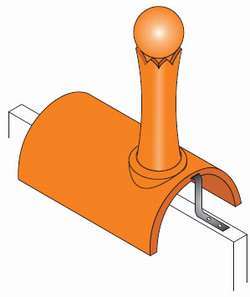Some examples of ornamental ridges
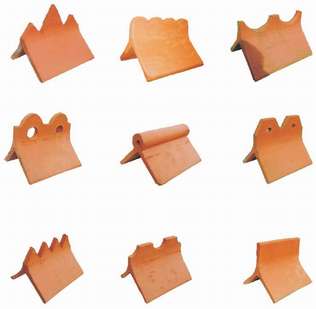
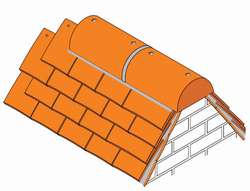
Gable stop end
This drawing shows an example of a gable stop end ridge tile. These are commonly used at the gable in conjunction with bedded verges and avoid the need for a deep bed of mortar underneath the end ridge tile.
All ridge tiles must be mechanically fixed to the roof structure in accordance with manufacturer’s instructions.
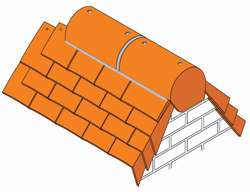
Block end
This drawing shows an example of a gable block end ridge tile. These are commonly used at the gable in conjunction with cloaked verges, although they can also be used with bedded verges to avoid the need for a deep bed of mortar underneath the end ridge tile .
All ridge tiles must be mechanically fixed to the roof structure in accordance with manufacturer’s instructions.
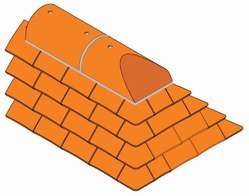
Hip ridge junction fittings
This drawing shows an example of a hip ridge junction. These are commonly used at the junction between ridges and hips on which bonnets, arris hips or a mitred hip have been used.
A suitable lead saddle (not shown) should be fixed underneath the end ridge tile to weather the ridge/hip junction. All ridge tiles must be mechanically fixed to the roof structure in accordance with manufacturer’s instructions.
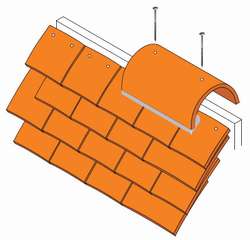
Mechanically fixed ridges – use of nails or screws or proprietary manufacturer fixings
This drawing shows an example of a mechanically secured ridge tile using nails or screws with sealing washers. The ridge tile must be drilled or specially manufactured with holes.
Where the ridge tree is absent, or of insufficient height or width to accommodate the fixings, it will be necessary to fit an additional ridge timber.
Where using this method of mechanically fixing in conjunction with mortar bedding it is better to use screws rather than nails to avoid the risk of dislodging the mortar during fixing. Some manufacturers supply proprietary fixing kits to mechanically fix bedded ridge and hip tiles.
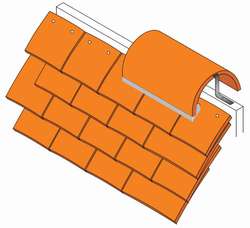
Mechanically fixed ridges – use of metal strap
This drawing shows an example of a mechanically secured ridge tile using a metal strap inserted into a recess at the end of the ridge tile and secured to the ridge timber.
This method of fixing requires the manufacture of special ridge tiles.
Where the ridge tree is absent, or of insufficient height or width to accommodate the fixings, it will be necessary to fit an additional ridge timber.
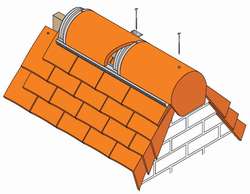
Examples of ventilated dry ridge systems
An example of a proprietary ventilated dry ridge system using ventilated strips on each side of the ridge to maintain a ventilation gap at high level.
Plastic joints provide a waterproof seal between the ridge tiles, which are secured using screws or nails and small metal plates.
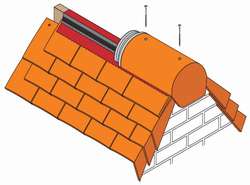
An example of a ventilated dry ridge system using a universal ridge roll.
The ridge roll provides high level ventilation as well as a seal at the ridge.
In this example holed ridge tiles are secured using nails or screws with sealing washers.
Examples of decorative finials
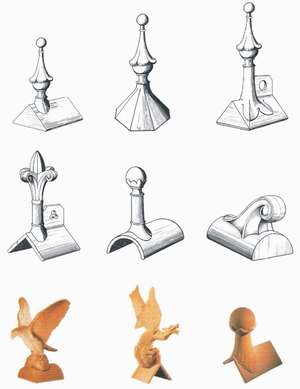
Mechanical fixing of finials
In this example the finial has a hole to enable it to be nailed or screwed to the ridge batten.
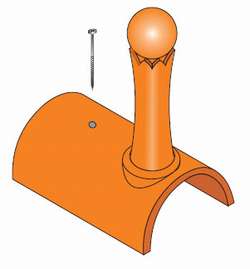
Using a nail or screw with sealing washer.
In this example the finial has a threaded bar embedded in it to enable it to be bolted through a suitable hole in the roof structure; for example, through a hole drilled in the ridge batten.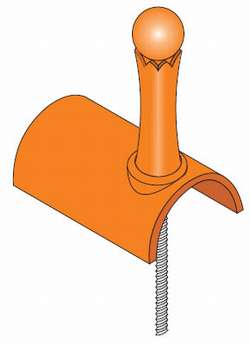
In this example the finial has a metal strap inserted into a recess at the end of the finial and secured to the ridge timber using nails or screws.
